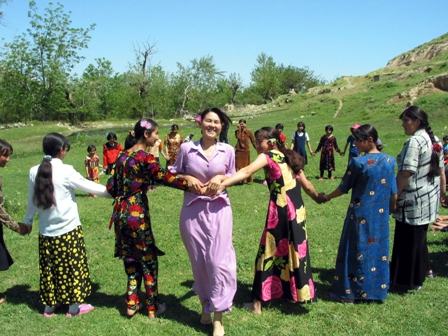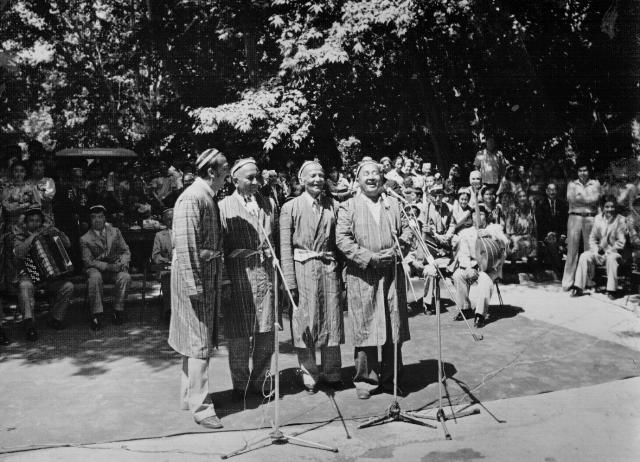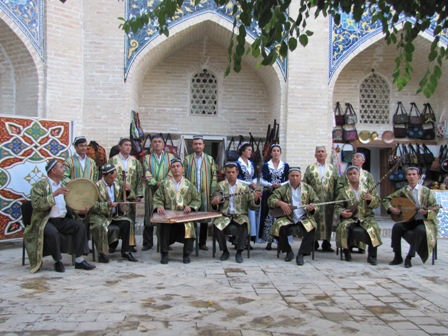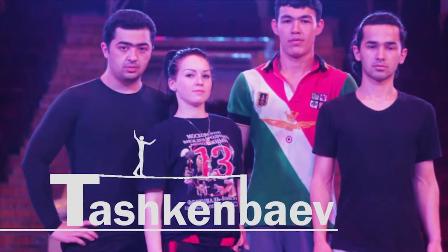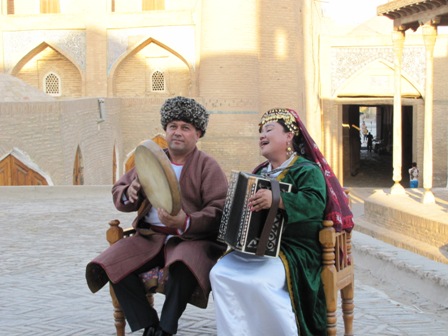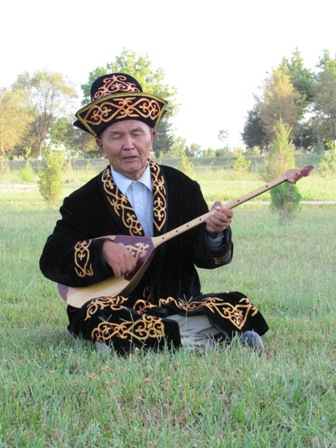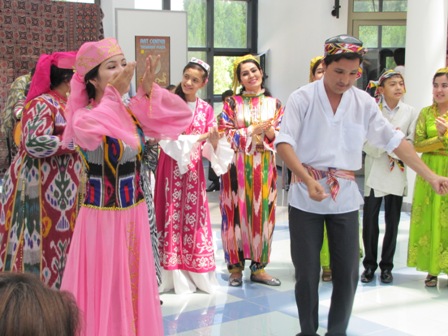Khoresm dances (Lazgi)
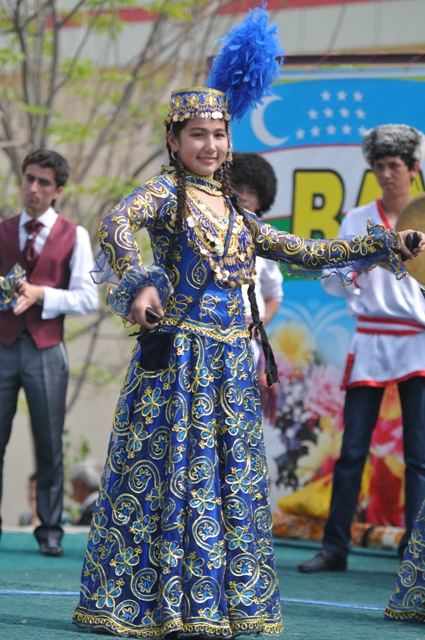
Khoresm dancing school emerged already in antiquity, and has evolved for centuries in Khoresm Oasis. This type of dance is rich in arm and leg movements. In both men's and women's dances it is typical to observe snapping of fingers, lofty stance, arm shakes and other body movements, knee drops, increase of tempo with a help of grindstones called "qayroq tosh" (finger cymbals), etc.
From among the dances, which came down to us, those which are performed by young men, such as "Chaghaloq" (dance of bird), "Yumronqoziq" (dance of marmot), "Norim-norim", "Aliqambar", "Orazibon", "Mori", "Khubbimboy", "Shirinnovot", stand out with their deep meaning, that can be understood thanks to the movements of hands, legs, and body. The dances named "Ashshadaroz" and "Maqom ufori" are considered to be purely women's dances.
In Khoresm there were whole sets of original men's dances called "oyin" (literally – "game", "dance"), which comprised of many poses (i.e. different positions of legs and arms, while the whole body was in active movement; with squatting and tapping). In this type of dance, a dancer spraddles his feet, stretches knees to sides and slowly squats while gracefully moving his body and accompanying himself with cajraks (stone castanets). Women's dances can be distinguished by virtuosity and scintillant movement of hands and shoulders; it is also possible to observe gruffish and somewhat emphasized movement of the whole body (torso). In Khoresm dance distinct types of dresses are worn as well. Men performed in white shirts called "Yaktag", which is tightened with the help of "belbogh" (waist kerchief). They also wore wide black trousers with soft leathered ichigi (something like high boots), and headdress made from caracul. Women-dancers wore dresses made from light and shiny materials, a skull cap and on the neck – a wide corsage of traditional jewelry items.
The most popular dance is called "lazgi". It is a type of Khoresm dance, which is energetic and full of passion. It is performed equally by both male and female dancers. "Lazgi" dance was usually accompanied by instrumental and dancy melodies. Although song versions of "lazgi" (which use various poetic texts) became widespread later on, the nature and character of melody remained the same. There are several versions of "lazgi" dance. These are: dance on a tray, dance on a brick, solo as well as group dance. In these, refined dance movements are replaced consequently by passionate and accelerated dance. The dance starts from steady movements of fingers of one hand and then another. Then simultaneously and slowly includes entire torso. The tempo gets accelerated and dancers snap fingers in time with dance with the help of stone castanets. Some specialists consider that this dance emerged at the time, when the first human (Adam) appeared on earth. They think that the God, while creating the first human being could not bring him to life because the spirit did not want to enter inside human's body. As a result the God made him enter inside human's body through music. And it is said that "lazgi" dance demonstrates exactly this process of bringing human to life.
In a group dance each participant dances in his or her own style. In ensemble performance the dance begins with slow and simple movements of each participant. First fingers begin to move, then arms, shoulders and finally - the whole body (torso). After this a swift transition to complex movements occurs. With repetition of a certain part of a melody dancing movements begin to change. And the more the nature of melody changes and the more rhythm accelerates, the "warmer" gets dance, and then ends swiftly. Men's dances are distinguished with mannishness. Women's "lazgi" dances, in contrast, are of lyrical and joke-like nature. At present there are 9 versions of "lazgi" in Khoresm. From among them it is possible to mention the following: "Qayrok lazgisi" ("lazgi" with stone castanets), "Lagan lazgi" ("lazgi" with plates), "Ghisht oyini" ("lazgi" on a brick) as well as those, which are performed under accompaniment of a song, such as "Kimni sevar yorisan?", "Loyiq", "Sani ozing bir yona", "Gal-gal", etc.
From among masters who took active part in promotion and development of Khoresm dance, it is possible to mention Onajon-khalfa Sobirova (1885-1952), who did a lot to preserve musical, poetical as well as dance traditions of Khoresm. She was a skillful accordion player, bright performer of folk songs and songs of dostons, creator of many poems and songs, teacher of dancing art. Also, what is important, she demonstrated particular scenic interpretation of songs, which were accompanied with dances. Great is also contribution made by such masters as S. Allaberganova, R. Khakimova, R. Otajonova (participants of the ensemble led by Onajon-khalfa), Qambar-bola, Kanarak-bola Saidov, Qodirbergan Otajonov, Khudoybergan toq-toq, Gavhar Matyoqubova, and others. Nowadays Khoresm dance traditions are being developed further thanks to the activity of many professional and folklore ensembles.





